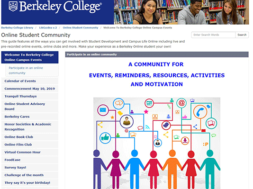
Four Areas of Distance Education Best Practices
By Osmin O. Smalls, BA, CPC, CPB, CEMC, CGSC, Program Director, Southeastern College
Whether you call it distance education, online learning, or e-learning, you are speaking of the type of education where the educator and the student are not in the same physical space. With technology, educators and students can communicate from remote locations.
We all remember going to school from 9 to 3. We either walked, took a school bus, took public transportation, or got rides from our parents. We were organized by age and subject matter and put into a classroom with 29 other students of the same age with a teacher who was responsible for educating us. This process continued into college. The lecture halls may have grown to be two or even three times as large, but the basic concept of the teacher and the student being in the same physical space for the purpose of teaching and learning was the same.
Times have changed.
Even though distance education is not new and can be traced back to the 1800s, by the mid-1970s, educational institutions started to see the value of distance education.
An institution can enroll students without having to use a physical classroom and students can continue to work and go to school at the same time. It was a win-win situation. Now the nontraditional student had an even greater opportunity to receive higher education. They can access their classes from anywhere and anytime that is convenient to their schedule. It seems that distance education is here to stay. If you are a distance educator, what are some best practices you can employ so that your students get the best education possible? Notice these four main areas.
Communication
Communication is one of the most fundamentally important best practices of distance education. Communication should happen with students often and in a variety of ways. Remind students of important deadlines; provide constructive criticism; offer additional resources; commend and praise; check in on them especially if there is unusual behavior such as turning in a late assignment when they are usually on time. Use a variety of methods to contact students. Electronic communication such as email, texting, and video conferencing is a must. Use features of your learning management system such as home page announcements or individual comments in their grade books. Electronic communication is fast and efficient but there is nothing like receiving a phone call. It provides a personal touch. This may carry more weight than an electronic message, especially if the student is struggling. Written communication should be used for contact with the student that requires documentation; however, a phone call lets the student know they are important and that we are interested in their success. Choosing the correct channel for communication is important.
Communication should be clear and concise. This is true because our audience has various educational, lingual, cultural, and perceptual backgrounds. Additionally, without the stress and inflection of the spoken language, the written word can be interpreted in a variety of ways. This is an important consideration because most instructions to our students in distance education are written. Notice this simple sentence: ‘I didn’t say he stole the money.’ It seems clear and concise … at first glance. However, did you know this sentence can be interpreted in seven different ways just by stressing a different word in the sentence? Try reading this sentence seven times and emphasizing a different word each time. You will see a change in the message every time. Fascinating! I remember thinking I provided clear and concise instructions for an assignment. However, when students were still contacting me for further clarification, I realized the instructions were not as clear as I thought.
Nonverbal communication has a tremendous impact on our students. It is estimated that over 90% of all communication is nonverbal. Notice the relationship Bambaeeroo and Shokrpour discovered in their research between nonverbal communication and the effect it can have on our students: “The correlation coefficient among the teachers’ non-verbal communication skills and the students’ academic achievement was 0.81 which reveals the significant relationship among these factors.” This is significant. What are we saying when we are not speaking? What message are we conveying by how we speak? This manifests itself with every interaction we have with our students. If we conduct live sessions, our dress and background should be appropriate. We want to smile and have a welcoming disposition as well. When we speak with our students, we never want to be condescending. Many of our students are working full-time while raising a family and attempting to educate themselves at the same time. Do you respect their effort, determination, and struggle? That respect should always come through when we interact with our students. Communication, in all its various forms, is a distance education best practice.
Provide synchronous learning
One of the many advantages of distance education is the ability for students to go to school asynchronously. This is especially appealing to persons who work full time or who have obligations that prevent them from getting their education in a synchronous format. However, a good distance education best practice is to provide synchronous learning as well. One way to accomplish this is through virtual live sessions. This allows students to take advantage of a live learning environment where they can form a connection with their instructor and classmates thereby reducing isolation. We should not overlook the importance of connection, which students state is imperative to learning in distance education. Isolation can make learning difficult and add to the already overwhelming challenges they are no doubt experiencing by attending school online. A live remote lecture via ZOOM or some other video conferencing format can reduce these anxious feelings because they feel their instructor is there to assist. Another benefit to a live remote lecture would be the ability for students to ask questions and get immediate feedback, which makes learning interactive and engaging for the student and the class.
Synchronous sessions via live remote should be held often – at least once a week. These sessions should be informative and relevant.
Remember, students are typically working full-time with obligations that prevent them from receiving their education in the traditional classroom setting.
Their time is limited. Use live sessions to emphasize the value of what they are learning and how it will benefit them in the real world. This will keep them motivated and remind students why they are making so many sacrifices to increase their education. Many instructors have multiple years of experience in the field they are teaching. Sprinkle the live sessions with examples or stories from that time, which makes the session interesting, and allows students to connect the material to the real world, while also helping with retention. I am a medical coder and biller, and I use to work for a great group of general and trauma surgeons who performed anal, rectal, colon, and trauma procedures from car accidents to stab wounds. I have many interesting stories to share from my professional experiences with my students! Consider using videos where appropriate. For example, when teaching students about the differences in the rate of growth between a normal cell and a cancerous one, I can tell them that cancerous cells grow faster and chaotically compared to normal cells but what an impression it makes when I show them in a short video! After learning about the central nervous system, I show my students a video of a recently excised brain in which a medical professional explains its various anatomical parts using the live brain. I am sure that makes a better impression than just explaining it to them. Try breaking students into breakout rooms and giving them a topic to talk about or a question to answer. After a few minutes, they can come together and discuss their findings as a class. Your LMS may have a polling function that will certainly get your students involved. Instead of a question and answer review, why not play a review game. As you can see, adding a synchronous component that is regular, engaging, informative, and fun is another distance education best practice.
Set students up for success
Many students are drawn to the distance education format because of the advantages of going to school in this way, but there are challenges as well. It would be a good idea to explore some challenges students may experience and come up with ways that can assist them. Some students have already taken online courses and have an idea of what to expect. There are also students who have never done this before but realize this is the only way, based on their current circumstances, to achieve their educational goals. These students will need more than just enrollment tools to be successful.
Train students on the learning management systems they will be using. This is the main tool students will use to complete assignments, assessments, reports, live sessions, and more. Students must receive an orientation at the beginning of their course on how to navigate the system. Depending on how the course is set up, it would be beneficial to walk students through their first week of class.
An advantage of distance education is that it allows students to access their class on their own time but that can also be a challenge. Time management skills are key. Encouraging students to have a schedule and to log into their class often should be emphasized from the very beginning. I would suggest a minimum of three times per week. A system can be set up where students get a friendly notification if they have not logged into class for a few days.
Distance education is made possible as a result of technology. Students should have a basic understanding of it. You would think that in this day and age everyone is familiar with technology but I have found this is not the case. Provide tutorials on basic computer literacy. Students should also have a resource they can go to if they cannot log into class or if their password has expired. These resources are very important as many students are going to class at non-traditional times when live help may not be available.
Have an open tutoring schedule available. This should be a time when students can just pop in without an appointment to get assistance if needed.
You may not want to call it a tutoring session because some students may feel it is only for those who are struggling. Whatever you would like to call it, have a time where students can interact with you live to get answers to their questions. On a side note, I have gotten to know many students this way on a personal level. It helps me to understand their circumstances and their struggles. If I need to reach out to them in the future to encourage or motivate them, the communication can be personal and unique to them. If a student cannot attend the open ’tutoring’ session, let them know what their options are. Do you have office hours? Can they call and schedule a one-on-one session? Students should be comfortable to reach out to get assistance. Announce the times on the announcement page, send emails and speak about it often in your live sessions. Students will then start to feel they are not alone and even though they are going to school online, they still can get assistance if needed.
Know your online learning system well
Have you ever seen an expert carpenter, hairstylist, or surgeon at work? They are very knowledgeable about their trade or craft, but they would not be good at what they do if they did not know how to use their tools well. Whether you use Blackboard, Canvas, Moodle, or some other learning management system (LMS), it is important to know the system well. This is essentially the main tool you will use to educate and communicate with your students. These learning systems have great features that will allow you to be productive and efficient but also to engage your students. Take a training course on how to use and navigate the LMS you are using. It is important to learn, not just the basic features, but the more advanced ones as well. Imagine being able to open a past due assignment or assessment for just one student with a legitimate reason instead of for the entire class. What about using a time-release feature that allows students to see their assignments when you choose or based upon the completion of a prerequisite assignment instead of it being visible all at once. This time-release feature can also be used for regular announcements. You can create them, let’s say, at the beginning of the class or semester and have them become available at the appropriate time. Another great feature is to personalize your grade book either by color or column organization so that at-risk students or assignments that need your attention are readily visible. If you have access to certain tracking mechanisms, you can keep track of what subjects, tests or assignments gives students the most trouble. Then make adjustments to how it is taught or provide additional resources. Some systems allow you to send feedback to your students in the form of a video. Imagine if a student opened their grade book and saw that! If you use your learning management system to have live sessions each week, use all the features such as the chat function, share screen, polling, and breakout rooms. The point is to make the best use of the tools that you are using so that you can provide your students with the best educational experience.
Conclusion
The advantages and convenience distance education provides ensure it will be around for the foreseeable future. We were able to explore four main distance education best practices that will allow students to be successful. These best practices are by no means an exhaustive list but it is a good start. Communication should be done often, using various methods, and should be clear and concise. Nonverbal communication is important and plays a critical part in the students’ success. Synchronous learning has many advantages. Make it informative, relevant, engaging, and fun. Set students up for success by acknowledging the potential challenges they may experience and create ways to navigate through them. Have a better than average knowledge of the learning system that will be used. It will allow for greater productivity, efficiency, and student engagement.
References
Bambaeeroo, F. &. (2017). The impact of the teachers’ non-verbal communication on success in teaching. Journal of advances in medical education & professionalism, 51-59.
Bayes, N. L. (2019). Medical Office Procedures (9th ed.). New York: McGraw Hill Education. Retrieved July 18, 2021
Bryant, A. (2019, May 16). A Simple Sentence with Seven Meanings. Retrieved from Learning English: https://learningenglish.voanews.com/a/a-simple-sentence-with-seven-meanings/4916769.html
Curtis, C. (2020, October 13). Isolated Students May Struggle to Stay Mentally Healthy. Retrieved from edutopia.org: https://www.edutopia.org/article/isolated-students-may-struggle-stay-mentally-healthy
Pappas, C. (2014, October 3). 11 Tips to Engage and Inspire Adult Learners. Retrieved from eLearning Industry: https://elearningindustry.com/11-tips-engage-inspire-adult-learners
Simonson, M. (2016, November 7). Distance Learning. Retrieved from Britannica.com: https://www.britannica.com/topic/distance-learning
Sudlesky, L. (2016, August 18). Synchronous & Asynchronous Learning in an Online Course. Massachusetts, Boston, USA. Retrieved July 18, 2021, from https://www.youtube.com/watch?v=nNuYcAHVALM
Tamm, S. (2020, March 21). 10 Biggest Disadvantages of E-Learning. Retrieved from e-Student.org: https://e-student.org/disadvantages-of-e-learning/
Why E-Learning Is the Future of Education Globally. (2021, April 22). Business World. Retrieved July 18, 2021, from https://link.gale.com/apps/doc/A659456393/GPS?u=lirn81758&sid=bookmark-GPS&xid=65b9f574
OSMIN SMALLS knows firsthand the advantages of distance education. She has a unique perspective as a student receiving her bachelor’s degree through Keiser University online and as an instructor who teaches medical billing and coding online. She has taught hundreds of students in nearly a decade in the classroom and online settings to be successful in their careers. Osmin is now the Program Director and the Program Chair of the medical billing and coding program at Southeastern College taught online. In addition to her bachelor’s degree, she holds multiple certifications through the American Academy of Professional Coders. Teaching is a privilege and brings her great satisfaction.
Contact Information: Osmin O. Smalls // Program Director, Program Chair // Southeastern College // 704-527-4979 // osmalls@sec.edu









